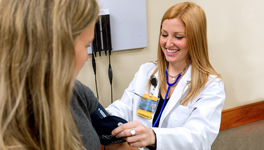
4/21/2017
Arkansas Association of Health-System Pharmacists
Primary Intended Outcome(s)
- Present content and expert knowledge to collaborative members on implementing an antimicrobial stewardship program
- Share technical assistance, best practices, and other resources through supporting partners in a statewide initiative
- Provide feedback on progress and data comparisons
- Assess and mitigate challenges to implementing a stewardship program
About Our Event/Service
AAHP has partnered with the Arkansas Hospital Association (AHA) to create a pharmacist-led antimicrobial stewardship collaborative. The collaborative has been joined by the Arkansas Department of Health (ADH) and the Arkansas Foundation for Medical Care (AFMC).
This collaboration started from the relationships and framework established when AAHP and AHA joined forces to start the Pharmacist-led Collaborative to Reduce Adverse Drug Events (ADEs) in 2014. We had a history of great success and had already developed strong relationships between hospitals and healthcare professionals, often contacting one another in between meetings to ask questions and share ideas. The next logical step for our collaborative was to initiate antimicrobial stewardship efforts, particularly with the expectation of Centers for Medicare and Medicaid Services (CMS) regulations and Joint Commission standards centered on antimicrobial stewardship.
In 2015, the collaborative held three one-day meetings where hospital pharmacists, pharmacy residents and students, Chief Medical Officers, Chief Nurse Officers, physicians, infection control practitioners, nurses, laboratory professionals, statisticians, information technologists, and patient leaders came together for learning and discussion. The sessions included presentations on stewardship program implementation, antibiotic usage data and measurement, strategies for overcoming barriers to change, and hospitals’ experiences about their implementation of antimicrobial stewardship.
The collaboration led to a commitment of 22 hospitals to collaborate and share data every month. Each hospital chooses a targeted antibiotic or class of antibiotics and reports days of therapy per 1000 patient days, targeted antibiotic monthly costs, and overall antibiotic expenditures. Hospitals are also encouraged to implement and track compliance to a protocol for antibiotic therapy for a specific hospital chosen condition (eg. a protocol detailing when to treat urinary tract infections versus colonization). In addition to the in-person meetings held two to three times a year, the collaborative holds periodic conference calls that vary in content based on the needs of the participants. Content experts lead discussions on specific topics, data collection and measurement, or questions from participants. The meetings and calls are also open to hospitals that are not officially a part of the collaborative because the goal is to allow everyone to benefit.
Key Elements for Success
- AAHP and AHA had established a partnership in 2014 to focus on Adverse Drug Events (ADEs); this history meant we already had a network for sharing in place.
- The collaborative invited and involved practitioners from a variety of hospital settings, large and small, to accurately gauge the barriers of the state as a whole.
- The collaborative established what data to collect and how to report it up front, allowing for consistent data collection each month.
How Promoted to Members
The collaborative activities are promoted to all members via emails from AAHP and updates in the Arkansas Pharmacists Association’s (APA) newsletter as well as AHA’s Tuesday Takeaways. AAHP also targets hospital pharmacists in the state in addition to AAHP members; the goal is to get the word out to people inside and outside of our organization.
AAHP’s Education and Programs Council Chair serves as the point person and works with AHA to develop programming. We reach out to experts on various topics and try to utilize presenters from within the state as much as possible. We also invite people who are part of antimicrobial stewardship at their hospitals to share their experiences, whether they have an established program or are just beginning their efforts.
All sessions are free to attend and supported financially by AAHP and AHA. Continuing Education (CE) credit is provided as well.
Tools and Resources Used:
Personnel: AAHP’s Education and Programs Council Chair has led the efforts, but many members participate in the meetings, including students and residents. Advanced Pharmacy Practice Experience students sometimes contribute content, such as updating information based on new literature or writing clinical pearls to share with the collaborative.
Marketing: The in-person meetings and conference calls are promoted to members and nonmembers through email and newsletter correspondence. AHA sends out emails to remind participating hospitals to submit monthly data and follows up with hospitals having any issues obtaining data.
Supply Expense: AAHP and AHA partner to provide sessions at no charge. Sometimes we receive some support from industry, but we cover expenses for the space, programing, and CE. We utilize AAHP’s GoToMeeting platform subscription to hold the conference calls. Since 2016, the in-person meetings break for participants to go to lunch on their own, saving AAHP and AHA the cost of meals.
Return on Investment: The collaborative is allowing hospitals throughout the state to see improvements in their antibiotic usage, costs, and core antimicrobial stewardship activities. It also is showing pharmacists’ leadership impact in Arkansas, which demonstrate the value of pharmacy resources in medication management efforts.
Outcomes/What will change?
- We have increased recognition and implementation of antimicrobial stewardship practices and access to pharmacy data for stewardship purposes throughout the state.
- We have developed a network of pharmacists from diverse practice settings working on this topic to share best practices and overcome barriers to antimicrobial stewardship practices.
- Between 2014 and 2015, 17 Arkansas facilities increased their core antimicrobial stewardship activities by at least one according to the National Healthcare Safety Network (NHSN) annual facility surveys.
- Another benefit of the collaborative is the interdisciplinary collaboration within hospitals. For example, the Infection Control team is now more aware of what other departments such as pharmacy are doing in terms of antimicrobial stewardship. This has led to better support between departments and more accurate reporting in NHSN surveys.
Other Considerations
When we started out with antimicrobial stewardship, there were a lot of technical challenges in terms of how to access and report data, which we were able to overcome by sharing resources and experiences between institutions. Once Joint Commission announced that antimicrobial stewardship standards would be effective starting in 2017, some of the focus shifted from specific antibiotic usage data to how to meet the standards and helping hospitals prepare. However, that shift in focus still demonstrates the strength of the collaborative: we were easily able to share ideas for standardization and help hospitals meet the Joint Commission Standards because of our established network.
Suggestions for Other State Affiliates
- When forming a collaborative, involve all types of people—consider individuals from large and small hospitals, rural areas and cities, those experienced in stewardship and those new to it, different professions/departments. The more perspectives involved the better representation of practice throughout the state, and the more ideas generated to benefit everyone.
- Depending on the state (eg. number and size of institutions), determine what data is best to collect. It needs to be broad enough that it includes everyone, but not so broad that it cannot be analyzed. In Arkansas, the aggregate data became difficult to analyze because of the number of smaller hospitals in the state, the selection of different antibiotics by hospitals, and unpredictable occurrences such as drug shortages. As a result, the core antimicrobial stewardship activities in the NHSN facility surveys have been used to assess progress. Find a primary outcome that can apply to everyone, and if it is possible, collect the data for some secondary outcomes.
- Even if the focus of the collaborative shifts, such as it did for us with Joint Commission Standards, the collaborative itself is still beneficial and able to make an impact. The metrics originally used to assess it might no longer apply, but remember any victory is a victory.
- Share all ideas, including what has not worked. It is great to share success, but there is also much to be learned from what did not work out as expected.
- As hospitals get more comfortable with inpatient requirements, start thinking about other areas to expand the focus (eg. ambulatory services, transitions of care).
Future Plans and Goals
AAHP plans to continue working with AHA and our other partners to assist in developing policies and physician order sets, monitoring processes, and advancing other initiatives to help with antibiotic use. We have also identified a need to provide training resources to pharmacists who may want a refresher on the “bugs and drugs,”, and we are planning webinars and annual meeting programing for this purpose.
AAHP feels this collaborative has shown stakeholders in the state the value of pharmacy in leadership, and pharmacists have just been granted representation within the ADH Healthcare Associated Infection (HAI) Advisory Committee’s newly formed Antimicrobial Stewardship Subcommittee. There are many critical access hospitals and few Infectious Diseases trained physicians throughout the state, so there is a definite need for pharmacy involvement.
AAHP was asked to contribute to a bill initiated in the Arkansas House, which enabled the organization to provide verbiage to increase pharmacy leadership in antimicrobial stewardship at the ADH as well as individual hospitals. Unfortunately, this bill was pulled for now, but eventually, AAHP hopes for state antimicrobial stewardship legislation that allows for pharmacists’ leadership in stewardship programs. We anticipate a future bill will allow AAHP to address some of our concerns about pharmacy’s role in stewardship programs and the applicability of the legislation to institutions of all sizes.
Helpful References
- Brown, P. (2015). New Kid on the Block: Arkansas’s Antimicrobial Stewardship Collaborative. Arkansas Hospitals, Spring 2015, 19-20.
- Carver, N. (2015). Health-System Pharmacists Lead Quality Collaborative. Arkansas Hospitals, Spring 2015, 16-19.
- Centers for Disease Control and Prevention. Antibiotic Stewardship Implementation Framework for Health Departments. Updated November 2016. Available from https://www.cdc.gov/getsmart/community/programs-measurement/state-local-activities/framework.html . Accessed March 23, 2017.
- The Joint Commission (2016). New Antibiotic Stewardship Standard. Joint Commission Perspectives, 36(7),1;3-4;8.
Contact Information
Primary Contact Name: Marsha Crader, Pharm.D.
Position held in organization: Current Treasurer (Also Past President)
Phone: 870-243-1770
Email: [email protected]

ASHP Connect
ASHP Connect communities, discussions, and blogs devoted to pharmacy practice

Meetings
Conferences, meetings, workshops, and recertification courses for pharmacy professionals


